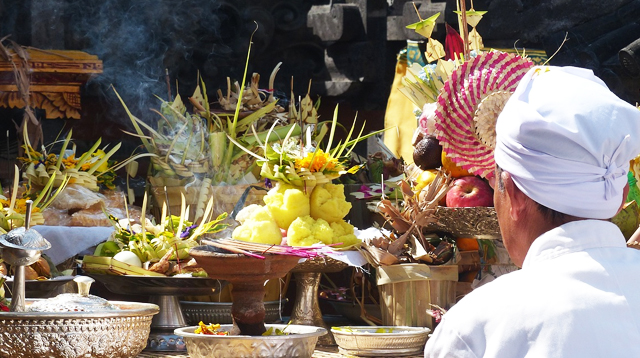BALI, the Island of the Gods, is renowned for its stunning landscapes, captivating culture, and, of course, its exquisite cuisine. But beyond the explosion of flavors on your plate lies a deeper connection, a sacred thread woven between food and ritual that forms the very essence of the Balinese way of life.
Offerings of Gratitude
Every day in Bali begins with an elaborate dance of offerings. Small woven baskets overflowing with colorful rice, vibrant flowers, and meticulously fruits are presented to shrines and temples scattered across the island.
These daily offerings, known as canang sari, saiban (food offerings) et cetera are not mere displays of devotion; they are nourishment for the divine, a way to express gratitude for blessings received and to appease the spirits that guard the land.
Food as a Celebration: Festivals Steeped in Culinary Traditions
The Balinese calendar pulsates with vibrant festivals, each one marked by unique culinary customs. During Galungan, the island celebrates the victory of good over evil with elaborate feast offerings known as Banten.
These towering structures, meticulously crafted from woven palm leaves and piled high with an assortment of local delicacies, symbolize abundance and prosperity. In contrast, Nyepi, the Day of Silence, observes a complete fast from all food and drink, a period of introspection and spiritual cleansing.
Various servings are made in relation to particular Balinese Hindu ceremonies. Some of these foods are specially dedicated for the ancestors and gods apart from being used for consumption.
1. Cakes and Fruits: are also presented on particular occasions through offerings in the form of gebogan, sodan and so on. Meanwhile, the offering presented daily after cooking is called saiban.
2. Babi guling or roasted suckling pig–used to fill in particular offerings such as temple festival, child rites and expression of gratitude for particular achievement or to pay a vow.
3. Sate lilit or twisted satay—used to fill in particular offerings, give away on customary ceremonies also known as penolak sok (giveaway), while smaller ones is used to fill in caru offerings or exorcism rite dedicated to bhuta kala.
4. Urutan or sausage and tum (minced meat mixed with salads, wrapped in banana leaf cooked by steaming) are used to fill in offering in Galungan celebration and others.
5. Komoh (clear soup)—is used to fill in sagi or food offering for ancestors when making a religious ceremony or other customary activities
6. Ayam panggang (roasted chicken) is used to fill in various offerings both temple festival and offering for human rituals and others.
Ritualistic Feasts
Beyond daily offerings and festival celebrations, food plays a central role in life-cycle rituals. From birth ceremonies to weddings and funerals, specific dishes are prepared and shared according to ancient traditions. These ritualistic feasts serve not only to nourish the body but also to strengthen the connection between the community and the spirit world.
A Fusion of Flavors: Reflecting the Island’s Rich Heritage
The Balinese food scape itself is a fascinating tapestry of influences. Centuries of trade and cultural exchange have left their mark on the island’s cuisine, evident in the use of aromatic spices from India, the subtle sweetness of Chinese ingredients, and the bold flavors indigenous to Indonesia. This unique blend of influences reflects Bali’s rich history and its openness to diverse cultural expressions, even in the realm of food.
A Journey Beyond the Plate
For visitors seeking a deeper understanding of Balinese culture, exploring the relationship between food and ritual offers a captivating window into the soul of the island. It’s a chance to witness the deep reverence for nature and the divine that permeates everyday life, and to appreciate the intricate ways in which faith and flavor intertwine to create a truly unique culinary experience.
So, the next time you can tray to savor the exquisite flavors of Bali, remember that you’re not just indulging in a delicious meal; you’re embarking on a cultural journey that unveils the profound connection between food, faith, and the very essence of the Balinese way of life.










